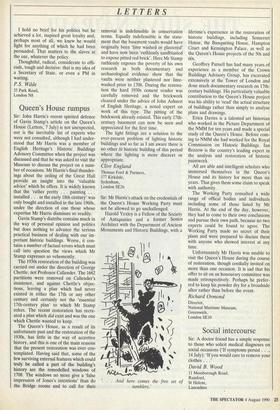Queen's House rumpus
Sir: John Harris's recent spirited defence of Gavin Stamp's article on the Queen's House (Letters, 7 July) is not unexpected, nor is the inevitable list of experts who were not consulted, although I had under- stood that Mr Harris was a member of English Heritage's Historic Buildings Advisory Committee when the project was discussed and that he was asked to visit the Museum to discuss the project on a num- ber of occasions. Mr Harris's final thunder- ings about the ceiling of the Great Hall provide an insight into the 'valuable advice' which he offers. It is widely known that the 'rather pretty . . . painting . . . installed, . . in the early 18th century' was only bought and installed in the late 1960s, under the direction of one those whose expertise Mr Harris dismisses so readily.
Gavin Stamp's diatribe contains much in the way of personal opinion and politics but does nothing to advance the serious practical business of dealing with our im- portant historic buildings. Worse, it con- tains a number of factual errors which must call into question the views which Mr Stamp expresses so vehemently.
The 1930s restoration of the building was carried out under the direction of George Chettle, not Professor Callender. The 1662 partitions were removed on Callender's insistence, and against Chettle's objec- tions, leaving a plan which had never existed in either the 17th or any other century and certainly not the 'essential 17th-century plan' to which Mr Stamp refers. The recent restoration has recre- ated a plan which did exist and was the one which Chettle wanted to keep.
The Queen's House, as a result of its unfortunate past and the restoration of the 1930s, has little in the way of accretive history, and this is one of the main reasons that the present restoration was ever con- templated. Having said that, some of the few surviving external features which could truly be called a part of the building's history are the remodelled windows of 1708. The windows no more give a 'false impression of Jones's intentions' than do the Bridge rooms and to call for their removal is indefensible in conservation terms. Equally indefensible is the state- ment that the basement vaults would have originally been 'lime washed or plastered' and have now been 'ruthlessly sandblasted to expose pitted red brick'. Here Mr Stamp ruthlessly exposes the poverty of his own research as both documentary and archaeological evidence show that the vaults were neither plastered nor lime- washed prior to 1708. During the restora- tion the hard 1930s cement render was carefully removed and the brickwork cleaned under the advice of John Ashurst of English Heritage, a noted expert on work of this type. The pitting of the brickwork already existed. This early 17th- century basement can now be seen and appreciated for the first time.
The light fittings are a solution to the ever-present problem of lighting historic buildings and so far as I am aware there is no other /it historic building of this period where the lighting is more discreet or appropriate.
Clive England
Thomas Ford & Partners, 177 Kirkdale, Sydenham, London SE26
















































 Previous page
Previous page